In the Tigray region of Ethiopia, beginning in November 2020, children who should have been laughing with friends and studying in school were instead locked up, crying, starving and abused in concentration camps, according to multiple eyewitness reports that have been corroborated by satellite imagery and analysis, as well as cell phone video footage smuggled out by an escapee.
Ethiopian federal forces, abetted by special forces, paramilitary groups, militia and police acting under the authority of the Amharan regional government, locked up in multiple locations hundreds of children of all ages — and even pregnant women, infants and toddlers — along with thousands of Tigrayan adults and senior citizens. These people appear to have been held in harsh conditions, systematically starved and beaten because of their ethnicity and with no judicial process or valid legal pretext. That is the definition of a concentration camp. This is a previously unreported part of an ongoing genocidal campaign led by Ethiopian Prime Minister Abiy Ahmed — ironically enough, a Nobel Peace Prize laureate — against various ethnic groups, including Tigrayans, Kimant, Gumuz, Ogaden (Somalis), Agew, Irob, Afar and Sidama, as well as Oromo people who fight to exercise the constitutional right to self-administration within a federal system.
The current civil conflict within Ethiopia is too complicated to explain here, and this report concerns just one aspect of it. As often happens in war, accusations and counter-accusations involving alleged war crimes have been made by the warring factions, which are primarily, the Ethiopian federal government forces, the Tigray regional government forces, the Amhara regional government forces and Amhara militia, and the Eritrean government forces. The Ethiopian embassy in Washington has not responded to Salon's questions about the specific and detailed evidence of human rights abuses presented in this report. If an official response arrives subsequent to publication, it will be included here.
Want a daily wrap-up of all the news and commentary Salon has to offer? Subscribe to our morning newsletter, Crash Course.
This report is based on eyewitness accounts by dozens of people from five ethnic groups, including 11 former prisoners who were interviewed in four different refugee camps in eastern Sudan. Doctors have recounted their treatment of another seven former prisoners, including young children. Satellite imagery from Maxar (a space technology company based in Westminster, Colorado) and Planet Labs (an Earth imaging company based in San Francisco) corroborates these eyewitness reports. So does video footage which one former prisoner shot on his cell phone before he escaped a previously unreported concentration camp in western Tigray, located in the notorious Abbadi warehouse compound in Mai Kadra.
The cell phone footage admittedly does not conform to classic notions of what a concentration camp looks like, as in World War II films.There are no bars, guard towers, German Shepherds, barracks, searchlights or coils of razor wire. In the videos, prisoners can be seen eating popcorn, drinking coffee, teasing each other and making jokes in Tigrigna, the language of the Tigray people.
 Dr. Mebrahtom Yehdago, 37, in Tenedba refugee camp, Sudan. (Jonathan Hutson)
Dr. Mebrahtom Yehdago, 37, in Tenedba refugee camp, Sudan. (Jonathan Hutson)
"Young children who were imprisoned and abused"
"We are seeing a generation of Tigrayan refugee children, many of whom are growing up with a sense of hopelessness," said Dr. Mebrahtom Yehdago, 37, from Humera. He is a Tigrayan doctor and refugee in Tenedba refugee camp in eastern Sudan. "As a doctor, I feel so disturbed, sad, and angry to see these kinds of situations. These children are innocent. These are young children who were imprisoned and abused. How can we get the world to pay attention and do more to help the children?"
Dr. Mebrahtom outlines the cases of former child prisoners in concentration camps whom he has treated: four boys, ages 2, 9, 13 and 15. The two-year-old was imprisoned with his mother in the Mai Kadra concentration camp – which satellite imagery shows is in the Abbadi warehouse compound, a bit north and across the street from the police station, just as eyewitnesses reported. They were imprisoned from Nov. 14 to Nov. 27, 2020, until the mother paid their captors — the Fanu, the Amhara militia and the Amharan Regional Police — a ransom of 50,000 Ethiopian birr (about USD $1,086) for their release.
The toddler presented with physical complications, Dr. Mebrahtom said, including recurrent diarrhea, dehydration, malnutrition and pneumonia, as well as psychological issues. For example, when the boy sees a large group of people, he starts shouting and crying. His mother says he is remembering their hardship in captivity.
Their captors provided no food or water. About twice a week, according to former prisoners who escaped, Doctors Without Borders (or MSF, its French acronym) workers from Abdelrafe would distribute packets of digestive biscuits and fill two large water tanks. MSF repaired one water tank and installed another, without which the prisoners would have had only a few sinks in the bathrooms, where toilets and floors were overflowing with feces. MSF also built a new bathroom. The prisoners in Mai Kadra, like those in other concentration camps in western Tigray, survived by pilfering and roasting sesame seeds stored in the warehouses where they were held captive. This meager sustenance came from bags of seeds that the Amharan forces had looted from Tigrayan farmers and hauled to the warehouses on trailers pulled by tractors. The tractors in Mai Kadra were stolen from the Abbadis, a wealthy Tigrayan family who had owned the warehouse compound.
Satellite imagery shows tractors hooked to trailers near the compound garage. Some prisoners who had Amharan relatives or friends, and who could get money brought to them, paid bribes to Amharan militia guards. In exchange, the guards would allow two or three small boys, around eight years old, to run to the market and return with a kind of flat bread called injera, which the prisoners would distribute.
Former prisoners estimated that the total number of prisoners in Mai Kadra was more than 3,000; some said the number was closer to 8,000. And of that number, eyewitnesses reported that at least 400 were children of all ages. There were more than 10 pregnant women, at least two of whom gave birth in a warehouse (one with severe complications). There were newborns, infants, babies, toddlers, young children, preteens and teenagers, as well as elderly people, some in their 70s and 80s. Multiple witnesses reported seeing "two old men who starved to death."
Mostly the children cried, former prisoners reported. They cried because they were hungry and had no money for injera. They cried because they were separated from a parent. They cried because they were sick.
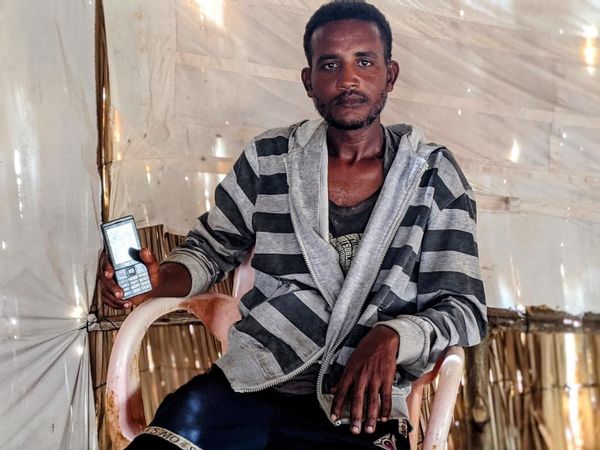 Solomon Kahsay, holding the Tecno cell phone that he used to shoot video from inside a concentration camp in Mai Kadra, photographed in Um Rakuba refugee camp (Jonathan Hutson)
Solomon Kahsay, holding the Tecno cell phone that he used to shoot video from inside a concentration camp in Mai Kadra, photographed in Um Rakuba refugee camp (Jonathan Hutson)
Resourceful resisters
The Tigrayan prisoners proved themselves to be resourceful resisters. They boys who fetched injera from the market started running other errands, to get smuggled cell phones recharged, or to buy solar chargers. One escapee, Solomon Kahsay, 32, posed for a photo holding the Tecno cell phone with which he shot three videos inside the concentration camp. He shot the videos on Nov. 30, 2020, during Hidar Tsion — an annual religious holiday dedicated to St. Mary — which the prisoners celebrated with coffee and popcorn brought by a boy from the market. Before he was locked up, Solomon drove a three-wheeled taxi called a bajaj.
Satellite imagery from Planet Labs geolocates the cell phone footage as a strong positive match with the Abbadi warehouse compound, according to analysts with the London-based nonprofit Vigil Monitor. Several eyewitnesses, interviewed separately in different refugee camps, authenticated the videos and identified people, places and things in the videos. For example, eyewitnesses recognized a three-year-old boy whom his mother carried on her back and an eight-year-old boy in a green, striped T-shirt — one of the market runners.
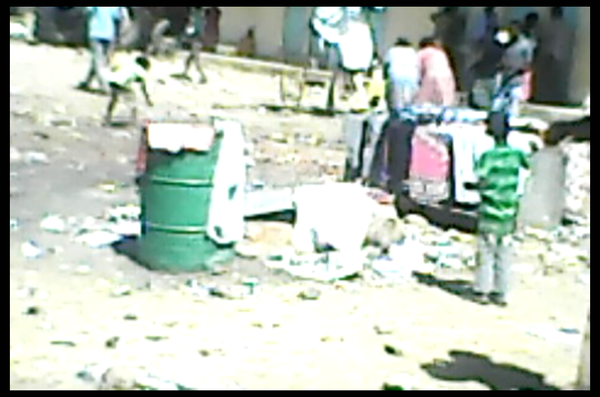 Screenshot of cell phone video taken by Solomon shows an eight-year-old boy in a green striped T-shirt. Escaped prisoners reported that this boy was one of several captive boys whom Amhara militia guards would allow to buy food from the local market.
Screenshot of cell phone video taken by Solomon shows an eight-year-old boy in a green striped T-shirt. Escaped prisoners reported that this boy was one of several captive boys whom Amhara militia guards would allow to buy food from the local market.
"We are here to kill you"
Dr. Mebrahtom described the case of a 15-year-old boy, imprisoned in the same place in Mai Kadra. He is an insulin-dependent diabetic. When he asked for permission to buy insulin from a local pharmacy, his captors said, "We are not here to treat you; we are here to kill you. We are gathering the Tigrayan refugees here to kill them."
The dividing line between a normal jail, prison or detention center and a concentration camp is clear enough: The latter is defined by arbitrary arrest and detention in harsh conditions based on ethnicity, during a conflict and without judicial process, especially where people are locked up indefinitely for no valid legal purpose (such as a quarantine or relocation on humanitarian grounds for the purpose of saving lives). The Abbadi warehouse compound in Mai Kadra appears to qualify as a concentration camp under those standards.
The Fanu freed the Tigrayan teenager on Nov. 29, 2020, after extorting from his family 15,000 birr (about $326). He had been locked up for two weeks. Although the boy now lives in a refugee camp, he has fallen through the cracks due to apparent corruption and lack of bureaucratic oversight, the doctor and other refugees explained. The boy has no ration card and does not know where he will sleep on any given night. When the doctor offers him money, the boy responds, "What is the importance of this?" He argues that his life is pointless.
Dr. Mebrahtom explains that the abuse of Tigrayan children in Mai Kadra was not unique. It was part of a pattern which the doctor has seen, and which other eyewitnesses confirmed in interviews, which also involved children locked up in various sites in the regional capital of western Tigray, Humera. For example, the doctor has treated a 9-year-old boy who had been imprisoned for four days in the old police station in Humera.
Eyewitnesses who had been incarcerated in the old police station, and who were subsequently transferred to the Yitbarak warehouse in Humera, from which they escaped, reported that the only food and water available in the station (administered by the Amhara Regional Police) was whatever the prisoners could buy and have brought in from outside. And in the Yitbarak warehouse (sometimes called the Tabarak warehouse), prisoners subsisted by pilfering sesame seeds from bags looted by the Amhara and stored in the warehouse. So this young child, like hundreds of other children and adults imprisoned in multiple locations, had to survive on handfuls of seeds and a little water, with an occasional supplement of a piece of injera or a few digestive biscuits. I asked the doctor who had arrested the 9-year-old boy, and why.
"The Amhara militia arrested him and beat him with sticks on different parts of his body because they said he is the son of a Tigrayan militia member," the doctor recounted, reading from his medical notes. "They traumatized his left eye, which he lost." His uncle ransomed the boy for 1,000 birr after four days.
The boy's eye socket healed with a clean scar and no infection. But he has no prosthetic eye, not even an eye patch. So the boy does not see himself as a whole person. Inside, the doctor said, he carries deeper scars.
"He has suffered psychological trauma," Dr. Mebrahtom reports. "He has poor appetite and difficulty sleeping. He cries. He is not interested in playing with his peers. His mood is depressed. He is withdrawn and communicates very little. He stays near his mother."
The mother reports, "He wakes up at midnight and cannot go back to sleep. He stares and says, 'For me, it is meaningless to live.'"
There is a psychologist available in the camp, whom the boy has seen. But the boy says that he feels that talk therapy makes no sense for him because they cannot replace his eye. He cannot imagine living a productive life without an eye.
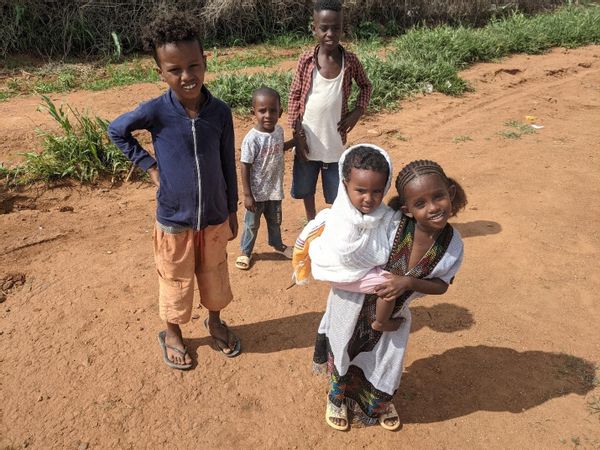 Tigrayan refugee children in Um Rakuba, Sudan (Jonathan Hutson)
Tigrayan refugee children in Um Rakuba, Sudan (Jonathan Hutson)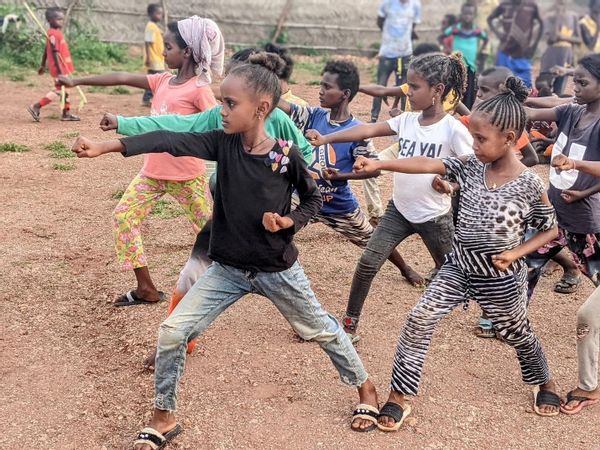 Tigrayan refugee children practice Tae Kwon Do in Um Rakuba refugee camp. (Jonathan Hutson)
Tigrayan refugee children practice Tae Kwon Do in Um Rakuba refugee camp. (Jonathan Hutson)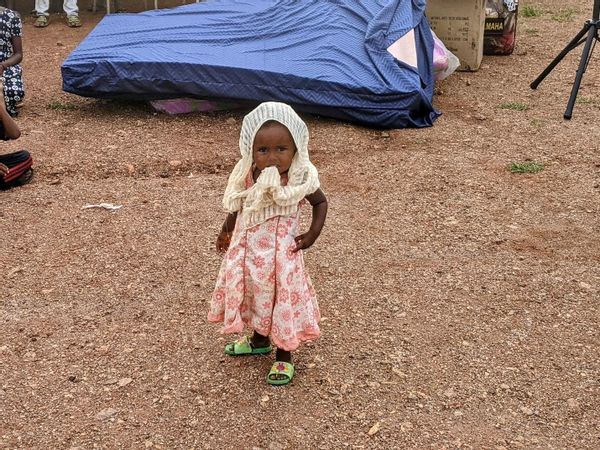 Tigrayan refugee girl in Um Rakuba, Sudan (Jonathan Hutson)
Tigrayan refugee girl in Um Rakuba, Sudan (Jonathan Hutson)
The doctor cites the case of a 13-year-old boy, the son of an Orthodox Christian priest, who was arrested while watching cattle. The Fanu stole his family's cattle and brought him to the Dansha police station, where he was imprisoned from Nov. 10 to Nov.18, 2020.
"The Fanu tied his hands behind his back with a rope," the doctor said. "They beat the ligature with a stick. As a result, he experiences weakness, a partial paralysis, in both hands. He did not receive medical treatment in detention." The Fanu released the child after his father paid 1,000 birr (about U.S. $22).
"He is depressed; his mood is very low. He is distracted, doesn't sleep well, and has lost hope," the doctor reported. "He says, 'I have no means of living a good life because my hands are useless.'"
The boy reported: "The Fanu said, 'We were created to cleanse your people from the surface of the earth.'" The boy believed them.
"The beaten children said nothing. But tears slid down their faces"
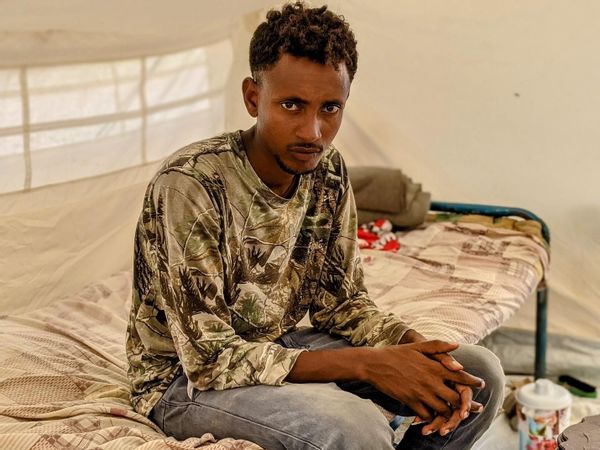 Ashanafe Syoum (Jonathan Hutson)
Ashanafe Syoum (Jonathan Hutson)
Ashanafe Syoum, 27, is a Tigrayan man who saw captive children when he was locked up in two locations in Humera. He reported:
On the fourth month, day nine of the Ethiopian calendar (Dec. 18, 2020), I was arrested and jailed in Humera because I am Tigrayan. The Amhara Regional Police arrested me and put me in the Gatar police station. When I entered, there were 180 Tigrayan male and female detainees, including about eight or nine children.
The Tigrayan children ranged in age from 10 to 15. The children sat near their families. They were so quiet because they were afraid. The children saw the police beat us, and they were afraid that they would be beaten, too.
I saw the police beat some children with sticks, too. When they beat the boys, they would say, "You are the son of the junta [a reference to the Tigration People's Liberation Front, or TPLF]." When they beat the girls, they said, "Daughters of junta." If they found children without their father, they would assume that the father must have left to fight for the TDF [Tigrayan Defense Forces]. The beaten children said nothing. But tears slid down their faces.
I was jailed there for two months and one week. The police gave the detainees nothing to eat or drink. But some prisoners collected money to send one person to go buy bread and water and bring it back, so that we could share it. We would each get a two-liter bottle of water for drinking and a three-liter water bottle per person for washing, about every three days. But sometimes, we could go a week without more water. Neither the Red Cross nor the MSF came when I was there.
After two months and one week [on Feb. 25, 2021], they transferred me to another prison, called Bet Henset, or House of Corrections. It was bad, too. If family members came to the prison to provide food to a prisoner, the Amhara special forces, who guarded us, would say, "No. It is enough. Go away." Sometimes, we did not get enough water there.
There were a lot of children in Bet Henset. There were more than 50 babies, ranging in age from a one-month-old,to a six-month-old to a one-year-old. There were about 70 children who were about five or six years old. Some would sleep next to their mothers; others would sleep next to their fathers. There were about 50 children who were around 10 to 14. There was no infant formula, baby food or special food for the children. When I was there, I did not see any Red Cross or MSF workers or hear about any coming to Bet Henset.
I was in Bet Henset about two weeks before four of us escaped.
Dr. Mebrahtom and three escapees, including Ashanafe, gave permission for their photos to be published, showing their faces and using their names. One escapee, Solomon, is photographed holding the Tecno cell phone which he used to shoot the cell phone videos showing children and adults inside the Mai Kadra concentration camp.
Escape from Mai Kadra
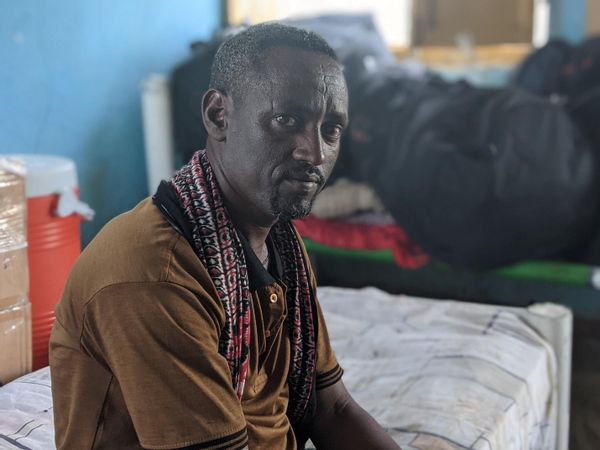 Kiros Berhane (Jonathan Hutson)
Kiros Berhane (Jonathan Hutson)
Another escapee, a 38-year-old tractor driver named Kiros Berhane, was the first man to escape from the Mai Kadra concentration camp, leaving through the south-facing warehouse door in the first of four groups who escaped over a four-day period. He reported:
When I arrived [in early November 2020], there were more than 6,000 detainees. The buildings are huge. There are two big warehouses inside the compound, and other two-story buildings for offices. They were not fully finished. The construction was still taking place. There were walls on top where they planned to build an additional floor. But the roof had not been added yet.
The roofless walls atop the warehouses appear in satellite imagery and in the cell phone video footage.
Kiros continued:
I can't say the exact number of children, but there were a lot. The children smelled bad because most had been beaten and injured. They beat us all when they captured us outside the warehouse. They beat everyone again as we entered. And they cut the cross from my necklace when I entered. They took crosses from the necks of many detainees. They tried to take every detainee's money, phone and some clothing, too. But some detainees were able to have phones. For example, some of us were sending children from the warehouse to the market, after three or four weeks, to bring us injera and to smuggle us some cell phones. The children had to get written permission from the Amhara to run errands. But this opportunity came later.
I know of a man named Solomon, who drove a bajaj. Solomon had a phone and was locked up with us.
For the first month, all we had to eat was sesame seeds which had been looted from a Tigrayan guy named Gerbreselasay. "Fento" was his nickname. Fento means the Ace from a deck of cards; Fento used to like to play cards. They killed Fento outside and stole his tractor with the sesame seeds and put it in a warehouse. These sesame seeds were in addition to the sesame that had belonged to Abbadi, which was already in the warehouse. I saw them drive off some of Abbadi's sesame seeds with a tractor. And I saw a tractor bring in seeds looted from Fento.
They started collecting us and making us stand in lines. Some Welkait Amharans who had grown up with us, and who knew our names, started making lists of our names and ethnicity. They took 180 Tigrayan people and put them in a separate room. Within a day, they took the 180-some young men; they took them away but did not bring them back to the prison. I saw this and decided to escape.
They also took a group of pregnant women, women with young children, old people and sick people, about 400 people, put the women in a bus and the men in a truck. They drove them toward Shire. They said, "We will take you to Shire." Some people said they left them near the Tekeze River, toward Shire. Some people say the Eritrean Army soldiers found them on the road and killed 80 of them.
The mother and her three-year-old boy who appear in the cell phone video footage were among the prisoners released on the western side of the bridge that crosses the Tekeze River toward Shire, the gateway to central Tigray. It is not known whether they survived the reported ambush by Eritrean soldiers.
Kiros continued, explaining how he decided to lead an escape at 5 p.m. on the 12-hour Ethiopian clock, on the fourth month, day 19 of the Ethiopian calendar. For Americans, that would be 11 p.m. on Dec. 28, 2020:
In the fourth month, day 19, I decided to escape after I saw them make a list of the young Tigrayan men and took them away, never to return. I believed that I would soon be with them. We had been studying the metal door at the rear of the warehouse for a month. The door faces south. The main door is huge, big enough for a tractor to drive through. There is a little door inside it.
There was a sliding latch on the inside of the little door. At the same time, there was an automatic lock with a key for use on both sides of the door. But the automatic lock didn't work. So, we learned that we could just slide the inside latch to open the door. If the automatic lock had worked, then we could not have escaped.
The little door opened toward the inside. It did not squeak when we opened it initially. A lot of people escaped after us, over a period of four days. It is possible that one of the later groups lubricated the door hinges. But the first group of escapees did not.
We played with the guards by giving them money to play cards and drink alcohol, and get drunk, so that we could escape.
The first group escaped in the fourth month, day 19. I am the one who decided to escape. I am the one who opened the door after a group of us had been studying the door and thinking about it for a month. There were eight men in the first group. We escaped at 5 p.m. on the Ethiopian clock. It was in the night. We ran west, toward Sudan. We had four one-liter bottles of water, which we call Highlands, plus some digestive biscuits from MSF that we had saved.
We ran without rest all night and the following day. We slept when we neared the border with Sudan, on the Ethiopian side, in a place called by its owner's name, Yamane's "gerag." We used to fix our tractors in his garage ["gerag"], next to his field. So we knew he was a friendly Tigrayan who had been born in Shire. But no one was there when we arrived.
We crossed the border with Sudan at a place called Allow. We were tired. We could not find water. We found Sudanese militia working in the fields. We went to them. They took our phones. But they gave us water. We entered deeper into Sudan, in a big agricultural camp called a "campo." After that, Sudanese civilians drove us in a big lorry filled with sesame seeds to Hashaba. They brought us to Hashaba and dropped us on the road. Some villagers led us to Village 8 refugee camp in Hashaba.
Over the next three days, other groups escaped and made their way here. Some females escaped, and some men and women were shot outside Mai Kadra while escaping. I am fine today. We are in a good situation. We have food. We have something to drink here. We can eat good meals from our country. Maybe soon, we will be able to go back to our country.
"We told jokes to keep from going crazy"
One man who was caught in an escape attempt suffered a severe beating, according to the accounts of former prisoners. They said the Amharans tied his legs and tied his arms behind his back and made him lie in the sun for two days in the courtyard, outside the shade of the big neem tree that stands there. Prisoners stopped attempting to escape after the fourth wave, when the Amharans reportedly began shooting escapees in the streets.
Every former prisoner referenced the neem tree, which is visible in satellite imagery and in the cell phone videos. Prisoners also described unfinished construction atop the warehouse roofs, and the fact that the two warehouses sat inside a compound at right angles to each other. They referenced outside stairs leading to a warehouse roof. They described tractors as well. All these features and objects can be seen in satellite imagery and cell phone video footage.
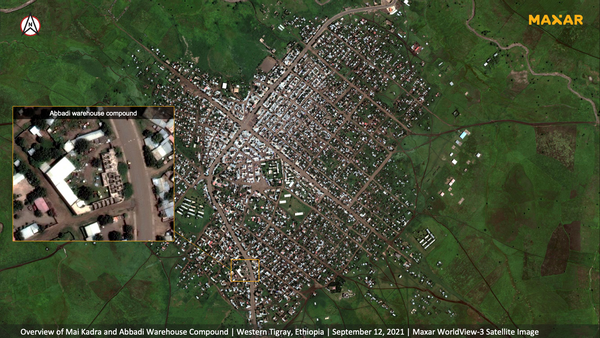 (Satellite image 2021 Maxar Technologies)
(Satellite image 2021 Maxar Technologies) (Satellite image 2021 Maxar Technologies)
(Satellite image 2021 Maxar Technologies)
Solomon reported that he shot the videos on a religious holiday when prisoners with connections had pooled money and paid bribes to send young boys to the market to bring treats, which they shared with those who had no money. He explained, "We told jokes to keep from going crazy. We smiled on the outside. But inside, we had different emotions."
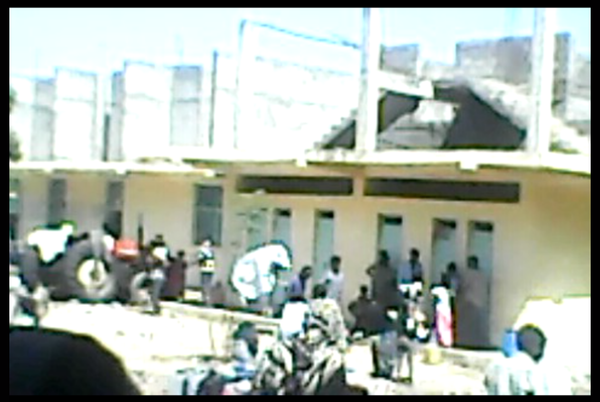 Screenshot from cell phone video taken by Solomon, showing a red tractor in the courtyard of the warehouse compound in Mai Kadra, and uncompleted construction atop a warehouse roof, just as former prisoners had described.
Screenshot from cell phone video taken by Solomon, showing a red tractor in the courtyard of the warehouse compound in Mai Kadra, and uncompleted construction atop a warehouse roof, just as former prisoners had described.
Five paths to freedom
There were five paths to freedom from the Mai Kadra concentration camp:
- the Amharan regional government released some who paid a ransom — an illegal act of extortion which confirms that there was no valid legal purpose for holding the prisoners;
- they released some who claimed Amharan ancestry, which confirms that the Ethiopian government was arresting Tigrayans because of their ethnicity;
- after several weeks, they released some old people, sick people, pregnant women and women with young children, although one witness among the released prisoners — a woman who returned to Mai Kadra — reported that the Amharans released these Tigrayans into a deadly ambush by Eritrean soldiers allied with Ethiopia's federal government;
- more than 150 Tigrayans escaped Mai Kadra over a four-day period; and
- some died of starvation and disease due to lack of adequate nutrition or sufficient medical care in captivity.
At the end of each interview, each eyewitness considered the question, "When peace comes, how will your life be different?"
They said that peace must come for everyone, on all sides of the conflict. They spoke of their yearning to reunite with family members, to rebuild their homeland and to return their children to school and to normal routines. Not a single person spoke of a desire for vengeance. They all hoped that the world would hear their stories and that the international community would respond.
Specifically, the refugees, including former prisoners, want the UN and NGOs to regain unfettered access to western and central Tigray in order to have a full accounting of each location where captives were held, including a full report on what populations were imprisoned, under whose authority and under what conditions. And they want culturally appropriate psychological and social support for doctors and nurses treating refugees, for survivors of sexual assault and for children of all ages who were imprisoned.
This reporter plans to go into Tigray to walk the sites of the concentration camps and interview former prisoners and their captors. And to find the three-year-old boy and his mother, two former prisoners whose faces stare from the video footage that Solomon smuggled out of Mai Kadra when he escaped. This is the first visual evidence corroborating eyewitness reports that the Ethiopian government has locked up children of all ages in concentration camps, starved them, beat them and told them they would die, in hopes that the world would turn a blind eye.



Shares